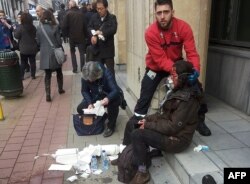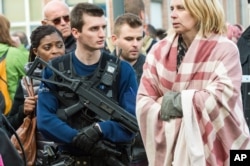Belgian police issued a wanted notice for a suspect in the Brussels airport bombing, one of three explosions claimed by Islamic State that rocked the capital Tuesday, killing at least 34 people.
The released photograph taken from closed-circuit television shows a man wearing a black hat, a light-colored jacket jacket, and sunglasses pushing an airport luggage cart alongside two other men who are believed to have been the suicide bombers.
Authorities say the wanted man fled the airport.
Police also say they found a bomb, chemicals, and an Islamic State flag during a raid on a house in a Brussels neighborhood while searching for the suspect.
The detonations, including an attack at a metro station, injured 130 others and prompted Belgium to raise its terror alert to its maximum level.
IS claims responsibility
IS said its attackers opened fire inside the airport, before detonating explosive belts, while a suicide bomber attacked the Maalbeek metro station, according to the militant group's Amaq Agency news site.
"This is a black moment in our country…everyone please be calm and show solidarity,” Belgian Prime Minister Charles Michel told reporters.
U.S. President Barack Obama, who was in Havana, said, "We will do whatever is necessary for our friend Belgium to bring those who are responsible to justice." He said the U.S. stands in solidarity with Belgium "for the outrageous attacks against innocent people."
Later he spoke by phone with Belgian Prime Minister Charles Michel to offer his condolences on behalf of the American people. The White House says he reaffirmed the United States' "steadfast support" for Belgium and offered assistance investigating the attacks and bringing the perpetrators to justice.
At least nine Americans are among the wounded, including one Air Force service member. Obama ordered flags lowered to half-staff on U.S. government buildings.
Hundreds of Belgians carried candles and flowers to a nighttime vigil Tuesday night at the Place de la Bourse in central Brussels.
European landmarks including the Eiffel Tower in Paris, Berlin's Brandenburg Gate, Rome's Trevi Fountain and the Burj Khalifa skyscraper in Dubai in the United Arab Emirates lit up with the colors of the Belgian flag.
WATCH: President Obama's statement on Brussels attacks
Airport attack
Video footage showed people fleeing the Zaventem airport in Brussels, as a double explosion at about 8 am local time shattered the massive windows, leaving glass and tile scattered on the airport floor and smoke curling into the chilly morning air. Local media reported a third unexploded bomb had also been discovered. News reports at least 11 people were killed in the airport blasts.
A European security official said one or possibly two Kalashnikov rifles had been found at the site of the attack.
Metro attack
The Brussels mayor said at least 20 people were killed and 55 injured in an explosion just moments later at the at the Maelbeek subway station near the main headquarters of the European Union. EU personnel have been told to either stay in their offices or at home.
Local media described panic on the street and people emerging from the metro with burns and wounds.
All flights in and out of the airport have been cancelled, and Brussels subway system has been shutdown as well. Authorities released surveillance images of three men who could be suspects.
The U.S. State Department issued a travel warning to American citizens throughout Europe, warning them to use caution at sporting events, tourist sites, restaurants, and on transportation. It also advised taking particular care at large festivals and on religious holidays.
Security boosted
Authorities in Frankfurt, London, Paris, and the Netherlands have boosted security at their airports in response to the Brussels' bombing. There is so far no direct link to the November terrorist attacks in Paris also claimed by Islamic State.
The White House said U.S. officials were in close contact with their Belgian counterparts.
The explosions come just days after the arrest of key Paris attacks suspect Salah Abdeslam in Brussels that have raised fears of revenge attacks to follow.
Max Abrahms, a political science professor at Northeastern University who focuses on terrorism, said the blasts were likely part of operations that were planned prior to the arrest.
"They were in the works and quite likely they were expedited in the immediate aftermath of the capture," he told VOA.
Crackdowns on terror groups often motivate terrorist cells to action, said Abrahms.
"There’s an incentive for these kinds of terrorist groups to strike back immediately after an apparent loss to the organization in order to communicate that the group isn’t dead," he said.
Link to Paris attacks?
The attacks also bring to mind the November 13 bombings and shootings, claimed by Islamic State, that took place in several places around the French capital.
A connection between the attacks and the arrest of Salah Abdeslam could be "extraordinarily significant," said Daveed Gartenstein-Ross, Senior Fellow, Foundation for Defense of Democracies. "Literally a watershed for terrorism and counter-terrorism in Europe. It represents the first time you’ve had a jihadist network carry out a major attack – the Paris attack – and then carry out a major follow-along attack," he told VOA.
A European diplomatic official told VOA, "We have to get used to it. We’ve been though this two times last year.”
The official also said recent data suggests there are possibly more than 3,000 people involved in terror networks in Europe and that follow-on attacks or copy-cat attacks are a continuing concern, though other officials say they have seen nothing to indicate anything is imminent.
VOA's National Security Correspondent Jeff Seldin and Richard Green contributed to this report
PHOTO BLOG: Brussels terror attacks














